




























































THE LAST MONTH has been busy, to say the least. I was fortunate enough to attend the Restaurant Gordon Ramsay residency at Matt Moran’s Aria restaurant for lunch a few weeks ago. Ramsay himself was in attendance, and I can confirm he’s tried a chiko roll — and was surprised to find it meat-free. Our very own Matt Abe is the chef patron of the three-star Restaurant Gordon Ramsay, who returned to Aria where his career all began for the soldout series — a nice full-circle moment for all.
As we hit the midway point of 2023, operators aren’t showing any signs of slowing down when it comes to the openings. David Bae is one restaurateur who has hit the accelerator this year with his newly formed group Kolture, which has become a critical cog in the return-to-roots



PUBLISHER Paul Wootton pwootton@intermedia.com.au
MANAGING EDITOR
Annabelle Cloros
T: 02 8586 6226 acloros@intermedia.com.au
DEPUTY EDITOR Amy Northcott anorthcott@intermedia.com.au
DISCLAIMER
Korean culinary movement we’re currently seeing. This issue, we also cover piquette — not quite wine, not quite sour beer — with two winemakers who are producing the eco-friendly beverage and delve into all things pizza with Deep Ends Pizza and City Oltra.
I’m pleased to announce tickets are now on sale for the Hospitality Leaders Summit in Melbourne on 31 July. We have a stellar line up of speakers who will be covering topics including staffing, social media and marketing, technology, sustainability and much more.
Until next time,
Annabelle Cloros Managing Editor
ADVERTISING NATIONAL Simon York
T: 02 8586 6163 F: 02 9660 4419 syork@intermedia.com.au
GROUP ART DIRECTOR –LIQUOR AND HOSPITALITY Kea Thorburn kthorburn@intermedia.com.au
PRODUCTION MANAGER Jacqui Cooper jacqui@intermedia.com.au
CIRCULATIONS To subscribe please call 1800 651 422. hospitalitymag azine.com.au facebook.com/ HospitalityMagazine twitter.com/Hospitalityed instagram.com/hospitalitymag
SUBSCRIPTION RATES
Australia:
1 year (10 issues) = $99.00 (inc GST)
2 years (20 issues) = $158.40 (inc GST) – Save 20%
3 years (30 issues) = $207.90
(inc GST) – Save 30%
SUBSCRIPTION RATES
New Zealand:
1 year (10 issues) = $109.00
Asia/Pacific
1 year (10 issues) = $119.00
Rest of World:
1 year (10 issues) = $129.00
This publication is published by Food and Beverage Media, a division of The Intermedia Group Pty Ltd (the “Publisher”). Materials in this publication have been created by a variety of different entities and, to the extent permitted by law, the Publisher accepts no liability for materials created by others. All materials should be considered protected by Australian and international intellectual property laws. Unless you are authorised by law or the copyright owner to do so, you may not copy any of the materials. The mention of a product or service, person or company in this publication does not indicate the Publisher’s endorsement. The views expressed in this publication do not necessarily represent the opinion of the Publisher, its agents, company officers or employees. Any use of the information contained in this publication is at the sole risk of the person using that information. The user should make independent enquiries as to the accuracy of the information before relying on that information. All express or implied terms, conditions, warranties, statements, assurances and representations in relation to the Publisher, its publications and its services are expressly excluded save for those conditions and warranties which must be implied under the laws of any State of Australia or the provisions of Division 2 of Part V of the Trade Practices Act 1974 and any statutory modification or re-enactment thereof. To the extent permitted by law, the Publisher will not be liable for any damages including special, exemplary, punitive or consequential damages (including but not limited to economic loss or loss of profit or revenue or loss of opportunity) or indirect loss or damage of any kind arising in contract, tort or otherwise, even if advised of the possibility of such loss of profits or damages. While we use our best endeavours to ensure accuracy of the materials we create, to the extent permitted by law, the Publisher excludes all liability for loss resulting from any inaccuracies or false or misleading statements that may appear in this publication. Copyright © 2023 – The Intermedia Group Pty Ltd
41 Bridge Road Glebe NSW 2037 Australia
Tel: 02 9660 2113 Fax:
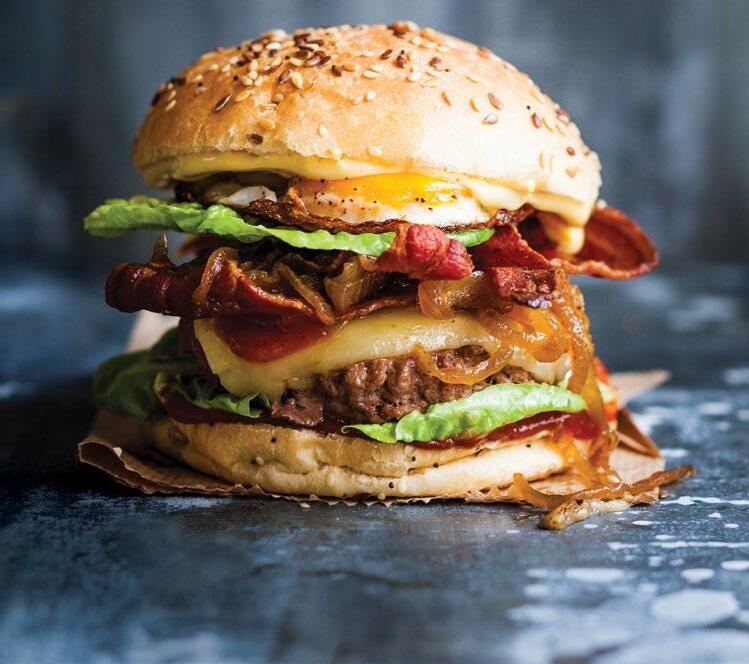




BABs’ pop-ups are championing women in food, wine, and beyond.


WORDS Amy Northcott
PHOTOGRAPHY Christopher Pearce and Haydon Fanning
BABS IS BEST explained by Ellie Hayes O’Brien: “Essentially, BABs is just a bunch of bad-ass bitches getting together and doing what they do best”. BABs is made up of Hayes O’Brien (chef), Bec Shave (restaurant and beverage manager), and Eva Balog (marketing and design), and sees the trio host monthly restaurant pop-ups at female-led venues. “BABs is a space for those working, living, and enjoying Sydney’s ‘eat food and drink booze’ culture,” says Hayes O’Brien. “It’s also a space for community and for the sharing of collective skills.”
BABs all started from a conversation between Hayes O’Brien and Shave at their workplace Rising Sun Workshop. “The concept of pop-ups was becoming more common,” says Hayes O’Brien. “[We thought] it would allow us to gain experience, feed our desire to work with incredible people in the industry, and share tasty food and wine with guests.”
The BABs team work with likeminded industry folk for each event, which has included Mariana Escalera Beverido (The Alex), Laura Rheinlander (Bar Vincent), Heather Moon (Ele), and Victoria Rose (Jane) so far. “One of our biggest goals is to collaborate with as many other women as possible and provide a creative space for them to showcase their skills and explore new ideas,” says Hayes O’Brien. “We always endeavour to demonstrate the kind of safe, supportive, and uplifting work environment we’d like to see more of in the industry as a whole.”
Since launching BABs, the trio have run events across Sydney’s Inner West including a Mexican-style dinner at Valentinas; an Italian feast at One Another; a French bistro showcase at Either Or; a Malaysian diner-style pop-up at Kurumac; a sausage sizzle at Young Henrys; and a 12-course long lunch at Mud Studios.
But a recent event saw the group head interstate for the first time to Melbourne. The BABs team joined forces with Cams Kiosk to host a Spanish- and Portuguese-inspired Sunday lunch at the Abbotsford Convent. “Planning an event in another city definitely came with its own set of unique challenges, but it was such a rewarding learning experience for us in the end,” says Hayes O’Brien. “We were so grateful to have the opportunity to work with a team of Melbourne hospo bad asses to bring this event to life for a new audience.”
Getting pop-ups off the ground usually starts with picking a venue and then thinking about a chef to collaborate with. The rest tends to come together from there. “We love showcasing the skills and experience of our chefs, so if a chef we want to work with is particularly [good] at making pasta, we’ll often build a concept around highlighting that skill,” says Hayes O’Brien. Once a theme is chosen, the team selects the kitchen and frontof-house teams for the event. Each pop-up also has a wine list curated by Shave, which aligns with the menu and its overall direction. “Each list has delicious wines made using minimalintervention [methods],” says Shave. “We are able to design the lists with wines made by women as sole winemakers or as partnerships.”
The hard work is certainly paying off, with all events receiving a positive reception from guests. “We have been absolutely overwhelmed by the response so far,” says Hayes O’Brien. “We have received a truly heartwarming outpouring of love and positive feedback from our customers, as well as a huge amount of support from the hospitality community.”

The immediate future for BABs will involve more interstate pop-ups as well as collaborations with industry peers. “We want to keep broadening our horizons and setting new challenges for ourselves,” says Hayes O’Brien. “We love working with new people and we’re very much looking forward to expanding the concept and introducing what we do to some new audiences.” Bringing people together over a shared appreciation for food, wine, and hospitality is at the core of what BABs is all about. “We always love meeting people who want to jump on the BABs train.” ■
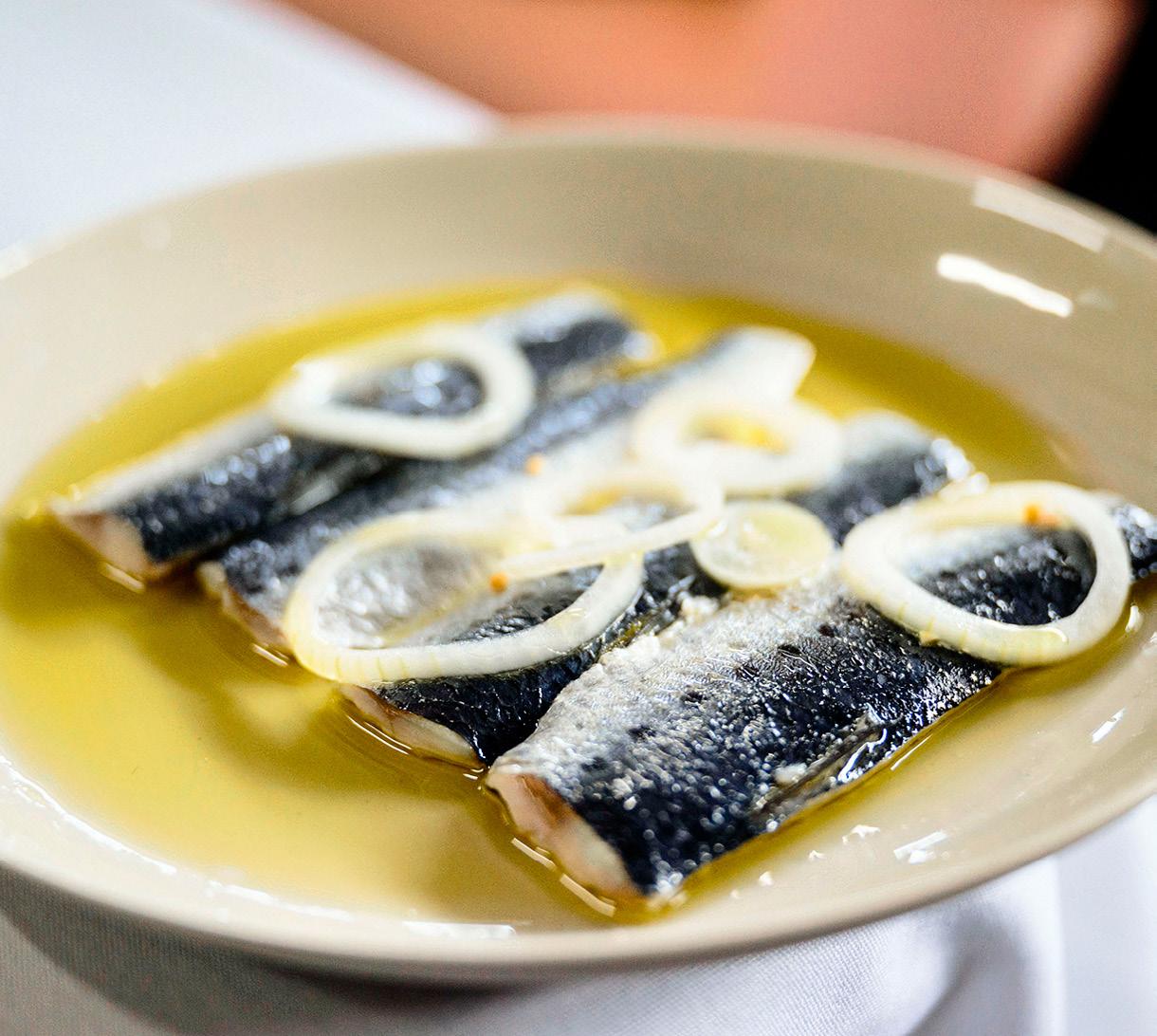
“We always endeavour to demonstrate the kind of safe, supportive, and uplifting work environment we’d like to see more of in the industry as a whole.”
–
Ellie Hayes O’Brien
Dorothy Lee and Jarrod Walsh will open Longshore in Sydney’s Chippendale this month. The restaurant is slated to welcome its first guests on 15 June and marks a new chapter for Lee and Walsh, who closed Hartsyard last year. Longshore will offer diners a multifaceted menu via à la carte, a 10-course snack flight, and a five-course degustation. “Our menu combines coastal ingredients with Asian techniques and flavours and will change regularly with what we like to call ‘freestyle cuisine’,” says Lee. Teaser dishes cover green lip abalone crumpet with guanciale and sansho pepper as well as steamed sand whiting with XO pipi butter, green garlic, and native greens. longshore.com.au

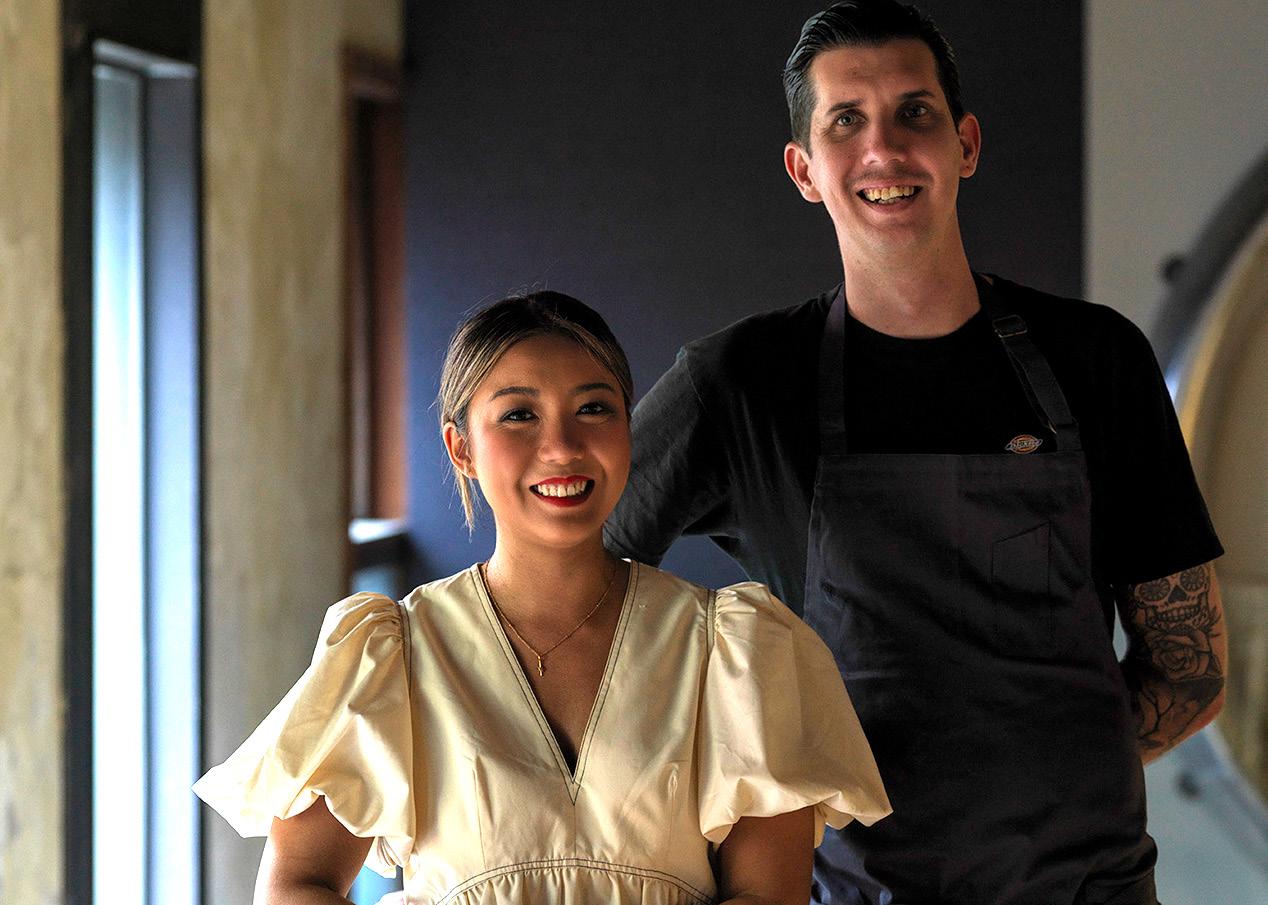
Photography by Jason Loucas
Malta
Simon Bajada
Hardie Grant Books ; $45
Author Simon Bajada explores his family heritage in Malta: Mediterranean Recipes from The Islands . There are 65 recipes for chefs to trial that draw influence from the country located between Italy and the North African coast. Dishes include ftira which sees sourdough soaked in tomato, tuna, and olives as well as pastizzi and aljotta soup with fish and garlic. Released 7 June.

Devon Hospitality Group have ventured into bistro territory with its new venue in Regent Place. The restaurant combines French and Japanese culinary influences and has seen Executive Chef Zachary Tan team up with Head Chef Andrew Lee to develop the menu. “Nido means twicecooked in Japanese and imparts the idea of taking an extra step, ensuring a constant pursuit of excellence and quality both on and off the plate,” says Lee. Launch dishes include aged bluefin tuna crudo and 14-day dryaged duck breast. Executive Pastry Chef Markus Andrew is spearheading the dessert section — don’t miss the crêpe suzette. bistronido.com.au


Totti’s Executive Chef Mike Eggert has spearheaded a new venue in Sydney’s CBD: Oti. The sandwich and Roman pizza concept has taken over the former Lorraine’s Patisserie location and is a dream realised for the chef and Merivale CEO Justin Hemmes. Come 11am seven days a week, diners can get their hands on house schiacciata and pizza piled high with prosciutto, salami, mortadella, burrata, or vegetarian options. Oti has a core menu as well as daily specials based on seasonal produce. merivale.com
World’s 50 Best Bar Maybe Sammy has officially shifted into new territory with the Mirage menu. Each member of the team developed a cocktail based on a “personal mirage moment”, which has seen creations inspired by everything from international night markets and Burning Man to the ocean. One Night in Bangkok emulates the classic Thai dish mango sticky rice via puffed rice-infused Ketel One vodka teamed with fortified wine and a coconut mango pearl. “We want our team to take ownership over this collection of cocktails and not feel like they’re just executing great cocktails developed by someone else,” says Creative Director Martin Hudak. maybesammy.com
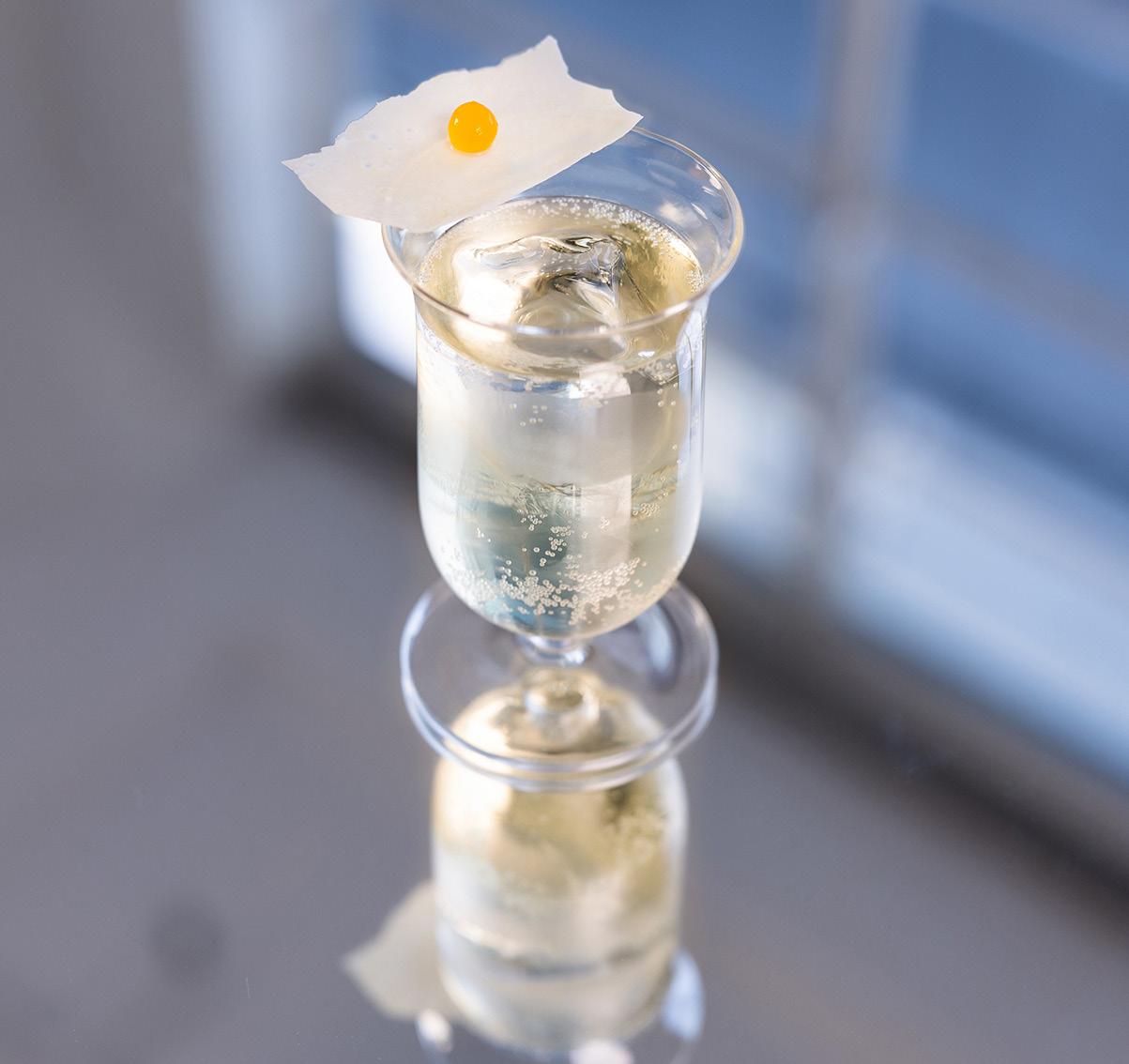 Photography by DS Oficina
Photography by DS Oficina

Frank Mac’s and The Doss House are now under the ownership of Ciara Doran, who has announced her new hospitality group Heritage House Co. Doran has run the bars since they opened, with the original partnership structure of both venues recently dissolved. “I have poured my heart and soul into The Doss House and Frank Mac’s, so it’s very rewarding to be able to call these two my own,” says Doran. “Both venues occupy spaces built in the 1840s and it’s been a real honour to repurpose these character-driven venues steeped in history into bars that can continue to be enjoyed.”
Photography by Steven WoodburnThe Dinner Party

Martin Benn and Vicki Wild Hardie Grant Books ; $60 Hospitality powerhouses
Martin Benn and Vicki Wild of Sepia and Society have penned a tome on the art of the dinner party. The book lists nine curated menus that chart memorable feasts, relaxed gatherings, and glamorous celebrations accompanied by wine pairing recommendations, cocktail recipes, and playlists. There are more than 70 recipes in the book that emulate those served at Wild and Benn’s own shindigs. Released 2 August.
Features in za’atar and herbes de Provence
Marjoram, also known as Origanum majorana or sweet marjoram, is a perennial herb that is part of the mint family. It is closely related to oregano, which is sometimes referred to as wild marjoram. It is believed marjoram originated in the Mediterranean and western Asia. It was prevalent in ancient Greece where it was used for medicinal purposes and recognised as a symbol of love and happiness. It was also used in ancient Egypt as a medicine and as part of the embalming process. Nowadays, marjoram is widespread and commonly found across Italy, Greece, Turkey, and Egypt.
The herb grows best in arid and semi-arid climates with warm temperatures. It thrives in full sun and should be sheltered from heavy rain during wet seasons as it doesn’t require a lot of water to survive. Although it is referred to as a perennial plant, marjoram doesn’t fare well in cool temperatures and frost, which can kill it.
It’s recommended to sow seeds indoors in early spring before moving them outdoors once the cold weather passes. Seedlings should be planted in sandy or loamy soil about 30cm apart in an area with full sunlight.
Marjoram plants grow between 30cm and 60cm tall
and have a shrubby appearance with fuzzy, oval-shaped green leaves. White or pink flowers bloom during mid to late summer and should be pruned before they flower to promote growth. It usually takes up to three months after planting for marjoram to be ready for harvest. Marjoram can be picked multiple times during the growth phase, usually when buds appear.

Marjoram can be used fresh or dry and is described as a milder and slightly sweeter version of oregano. It has a woody and earthy base with bitter, floral, citrus notes. Dried marjoram
Works well in poultry stuffings and seasonings
Used
works well in seasonings, stews, marinades, sauces, and stuffings. When used fresh, it should be added towards the end of cooking to ensure the flavour is preserved.
The herb is commonly used in mincemeat mixtures and in marinades for proteins, in particular poultry, veal, lamb, beef, and pork. It can also be added to marinara or tomatobased pizza sauces. Vegetablewise, fresh marjoram is ideal in different salsas, pico de gallo, or salads. Marjoram also features in spice blends such as herbes de Provence and za’atar as well as in the mixture used to make Polish sausages. It can be used as a milder replacement for oregano in certain recipes, too. ■
The perennial herb has a woody, earthy flavour ideal for stuffings and seasonings.white or pink flowers Part of the mint family Closely related to oregano for medicinal purposes in ancient Greece and ancient Egypt Thrives in full sunlight and warm climates Can be added to marinara and tomatobased sauces
Three times hospitality businesses should think insurance.
RUNNING A HOSPITALITY business can be stressful, and with so much to juggle, renewing your business insurance is often towards the end of the to-do list. BizCover knows a big chunk of small business owners admit insurance is the last thing they consider when making business decisions.

But not thinking about business insurance could lead to a situation like not being covered when something goes wrong.
Here are three scenarios where hospitality business owners should think insurance.
As a business develops, revenue stream may increase and new employees may be onboarded to help keep up with growing demand. While it is great for business, it could mean your business insurance may not cover the new risks you face. Ensure the policy reflects the current size of your business.
2. Business circumstances changed? Think insurance
New technologies and regulations can make or break your business. Or maybe you have had to adapt your product or service to compete in the new environment. When circumstances change, it’s a good idea to ensure your insurance has got you covered.
When running a business, there are various risks that may affect customers and suppliers such as accidents caused by understaffing or untrained workers, which could lead to claims against the business. It is why it’s important to consider if your policy includes/has enough public liability insurance* to protect against third-party injury or property damage.
Additionally, it’s important to consider the risks to the business itself due to events such as fire, theft, or accidental damage, which may impact assets such as stock,
equipment, and commercial premises.
Business insurance* is a package designed to provide cover for these assets and may need to be updated if any changes are made to the business premises or if there is an increase in external risks.
Business insurance is there to protect you from the current risks you face. By not thinking about whether your risks have changed, these problems could become a lot worse if a claim were made against you.
We know you’re not going to think insurance every day. But hopefully, if these three situations arise, you’ll be urged to think insurance and review your cover. With BizCover, buying business insurance has never been easier. Jump online and compare quotes from a range of leading Australian insurers and you could be covered in minutes.
Visit bizcover.com.au to compare quotes or call 1300 249 268. ■
*This information is general only and does not take into account your objectives, financial situation or needs. It should not be relied upon as advice. As with any insurance, cover will be subject to the terms, conditions and exclusions contained in the policy wording. © 2023 BizCover Pty Limited, all rights reserved. ABN 68 127 707 975; AFSL 501769
HAVE YOU NOTICED some venues aren’t complaining about lack of staff or their attitude?
They’ve probably figured out what it takes to be the local employer of choice (EOC), giving them a massive advantage in a world of tight employment. Unfortunately, paying well and providing a few perks is no longer enough. We need to think differently about attracting the best staff — offering to treat them like family and talking about a ‘passion for excellence’ doesn’t cut it anymore … unless there’s a lot more on offer.
Workers want a flexible job, a chance to learn new things, and have balance between work and home life. They want the workplace to be friendly, efficient, and well-organised. They also want it to have a positive culture and values they can believe in. Words such as respect, teamwork, integrity, excellence, innovation, responsibility, diversity, sustainability, customer focus, and fun are probably in the staff manual of an EOC. They’re on the noticeboard and a part
of everyday work, not just as clichés, but as guidelines for the team. Let’s unpack more of what’s desirable.
It starts with an online application form; text and email confirmation; a structured onboarding system; and online rostering. Apps and hospitality technology streamline tasks and the customer experience — employees know what’s expected of them and have the tools to succeed. It could include recipe and order management and display systems in the kitchen to maximise efficiency and control costs. For front of house, POS systems should be tailored to ensure speedy service. QR code ordering for customers, online bookings, and careful attention to online reviews should also be top of mind.
Management can’t just talk about work–life balance, they need to provide flexibility when
obstacles arise and ensure staff take regular time off. The workplace should be clean and safe, nutritious staff meals provided, and adequate breaks given to rest and recharge. There’s recognition for hard work and commitment and encouragement for friendships.
There are regular team meetings to share important information and address questions. Open and honest feedback is encouraged, and technology is used to keep everyone connected: email, messaging, and use of Slack, WhatsApp, or Facebook groups.
It could be Cert I for frontline workers or a chance for cooks to turn their experience into chef qualifications. Informal training and coaching should be available every few weeks on menu changes, service challenges, industry trends, and improved use of technology. Management also needs to be ready to train people

from scratch, understand the challenges and benefits of working with young employees or those from overseas, and support their growth within the business.
An EOC business prioritises flexible arrangements such as part-time work and shift preferences, and exercises understanding when it comes to employees’ personal lives outside of work. We all learned a lot from Covid-19, and there are even work-from-home opportunities in hospo when it comes to finance, ordering, and marketing — who’d have thought?
Good people want to work with others who have a positive attitude, even if they’re still learning. The modern employer of choice has high standards and doesn’t tolerate people who don’t respect company values or support the team. There aren’t many vacancies because people don’t often leave a good workplace. ■


Thirst quenchers, slow sippers, and all things beverage related.
 EDITED BY Annabelle Cloros
EDITED BY Annabelle Cloros
South Australian winery Yalumba have released the 2018 vintage of The Caley Cabernet Sauvignon & Shiraz globally, making it the sixth vintage to launch since 2012. “It was an even ripening season, delivering fruit with fine tannins, natural acidity, and strong varietal flavours,” says Proprietor Robert Hill-Smith. “We had many options for our blend, but our Coonawarra Cabernet block was exceptional this year.” Available from fine wine retailers and Yalumba for $365. yalumba.com

Banks and Bloom Distillery + Lab’s Ice vodka has secured double gold at the 2023 San Francisco World Spirits Competition. The vodka has been in production for just under a year and is made using a cold vacuum distillation technique that ensures the flavour profile of each botanical is preserved. The liquor features blood lime, saltbush, and samphire, resulting in a vodka with notes of citrus, vanilla, caramel, and almond. Available from independent Western Australian bottle shops. banksandbloom.com

Comet is the work of bartender Pita Dixon who launched the syrup brand after a decade-long development process. Each product is made from fresh fruit and botanicals, with the range covering raspberry and lemon myrtle; lemon, lime, and Makrut lime leaf; grapefruit and quandong; and hibiscus and lemongrass. The syrups can be used in everything from sodas and desserts to cocktails and mocktails. drinkcomet.co

Six sommeliers from Solotel’s Aria and Chophouse restaurants have come together to release Lot X — a range of limited-edition wines. Master of Wine and Group Beverage Manager Anette Lacey spearheaded the project which saw sommeliers work with wineries including Ravensworth and Alpha Box & Dice to create wines from Grenache and Fiano to Mataro and a Chenin Blanc amphora. “This is a terrific way to encourage their creativity and expand their knowledge and skills to include the complexity of the winemaking process,” says Lacey. The wines are available at select venues from $30. solotel.com.au
Aero and Milkybar are two of the most iconic sweet treats in Australia, and now chefs can incorporate them into their own creations. Nestlé
Professional have released Milkybar and Aero Dessert Mixes that are ideal for milkshakes, ice creams, cakes, mousses and more. The mixes are gluten-free and made with no added colours or flavours. Available from all major foodservice distributors or from Nestlé Professional. nestleprofessional.com.au

Comcater is Australia’s most trusted commercial kitchens expert. We live and love food service, cooking up the kitchens of tomorrow for more than 40 years. comcater.com.au

Piquette is gaining attention for its low-alcohol and sustainable qualities.
WORDS Amy Northcott
SecondTHE WORD PIQUETTE comes from the French nickname for bad wine. It’s also a derivative of the French word for prick or prickle, descriptors of the beverage’s light, sparkling character. Piquette is crafted from grape pomace, leftover grape materials that have already been pressed. While it is similar to wine, the beverage is more comparable to a sour beer or cider.
Piquette has slowly become more prevalent across the Australian winemaking scene and is now gaining momentum thanks to its lowalcohol content and light, easy-to-drink style. Hospitality speaks to Micah Hewitt from Defialy Wine and Kirstyn Keys from BK Wines about how piquette is made, the styles that can be produced, and what they think the future holds for the drink.
BK Wines in the Adelaide Hills have been making piquette for a few vintages now. The description for the Love is Blind #6 Piquette reads: ‘Let’s start with a basic fact: piquette is not wine’. So what is it? While piquette is made from the same ingredient — grapes — the fruit has already been pressed. Pre-pressed grapes means there is less sugar present, resulting in lower levels of alcohol — usually around the 5 per cent mark.
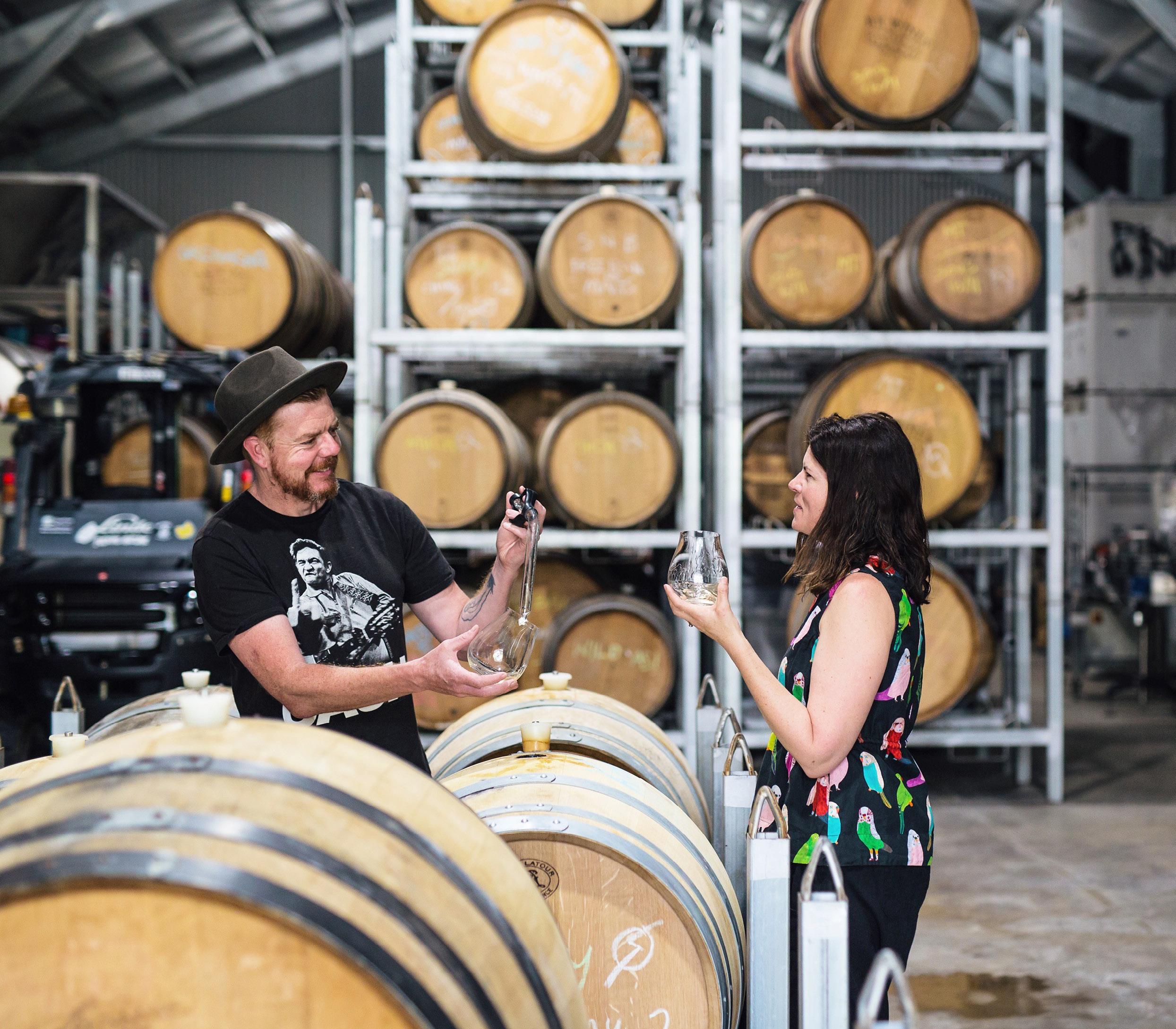
Piquette is made from grapes that have already been pressed
The drink is most comparable to sour beer
Owner and Operator of BK Wines Kirstyn Keys says the lightly pressed grapes are the base ingredient of the drink. “Filtered water is added to the grapes and it’s then left to ferment away,” she says. “We then press it and bottle it to capture the naturally occurring CO2 which makes a lovely, pretty, light drink.”
Micah Hewitt from Defialy Wine in Victoria’s Macedon Ranges has been making piquette since 2020, and says it sits in the cider and sour beer space. “There’s still a bit of the sugar left in the pressed skins from the original grape,” he explains. “So when it is rehydrated with water, it basically ferments like normal grape juice would and that results in a low-alcohol beverage.”
As Hewitt explains, the method does not differ too much from winemaking. “Essentially, it’s the same sort of process, but you don’t need to have them on the skins for as long,” he says. “It is also a lot quicker to ferment — a wine could take one to two weeks to fully ferment, whereas a piquette can take three days.”

Defialy Wine made its first piquette in 2020 from seven grape varieties
Piquette sits around 5 per cent ABV
There’s a lot of room for experimentation with both white and red varieties when it comes to making piquette. “You can use any grape,” says Keys. “We use Pinot Noir, Chardonnay, and Pinot Gris which are picked early for sparkling wine and leave natural acidity in the piquette.” BK Wines currently produces Love is Blind #6 and 2021
Good Name #3, which both have a Rosé-like shade, refreshing acidity, and notes of watermelon and raspberry.

Hewitt says he often uses varieties that are around at the time rather than being too specific.
“I wouldn’t say there’s a type most people use,” he says. “It’s generally whatever winemakers have.”
That being said, red varieties tend to be more suited for piquette as grapes are picked at a later stage, resulting in more residual sugar after they are pressed. Hewitt proposes Pinot Noir or Syrah for red varieties, while aromatic white styles such as Riesling and Gewürztraminer work well to enhance the flavour of the end product. Defialy Wines currently produce Unholy Water piquette which is made from whole-bunch, biodynamic Riesling and Sauvignon Blanc.
Grapes aside, the most important factor of making piquette comes down to concentration. “The problem you face with piquette is it can lack body because there isn’t that higher alcohol,” says Hewitt. To ensure a well-rounded drink, Hewitt uses a higher ratio of oxygen to water. “It’s really important to get characteristics into it, so texture, tannin, and acidity.”
The low-alcohol, slightly effervescent, light style of piquette means it’s the ideal drink to commence or conclude a meal.
“Piquette can be a great aperitivo; just make sure its chilled really
“[Piquette] has certainly sparked interest especially with more people looking at lower-alcohol beverages.” – Kirstyn Keys
well as it’s best served cold,” says Keys. “It’s a great alternative to sparkling grape juice and Champagne.” Hewitt proposes piquette as an option for times when one would usually opt for a beer or a cider. “Sometimes you want something more interesting or for when a beer might leave you feeling a bit full,” he says.
Both Keys and Hewitt believe piquette’s low alcohol levels and method of using discarded grape pomace will see the drink’s popularity soar with winemakers and drinkers alike. Utilising grape waste was the motivation behind BK Wines’ decision to start making piquette. “We are on a journey to create zero waste in our winery and vineyards,” says Keys. “It [piquette] has certainly sparked interest, especially with more people looking at loweralcohol beverages.”
Hewitt has also found piquette as an ideal platform to redivert grape waste. “I thought it was a really cool way to get a second use out of the grape skin,” he says. “It’s a little bit different and fun to experiment with.”
Defialy Wine made around 500 litres during the first vintage with piquette, utilising around six to seven grape varieties for the drink. “Whenever I had pressed grape skins, I’d just experiment and make batches,” says Hewitt. After the success of the first vintage, Hewitt has produced piquette annually, and believes it has grown in popularity. “Piquette is probably where pet-nat was
five years ago where no one knew what it was, and now there are so many,” he says. “Everyone has started making them [pet-nat] and now there’s more of a saturated market.”
Piquette is still in the process of being understood and accepted by the drinking public, but as more winemakers opt to make it, it’s poised to become a mainstay. ■
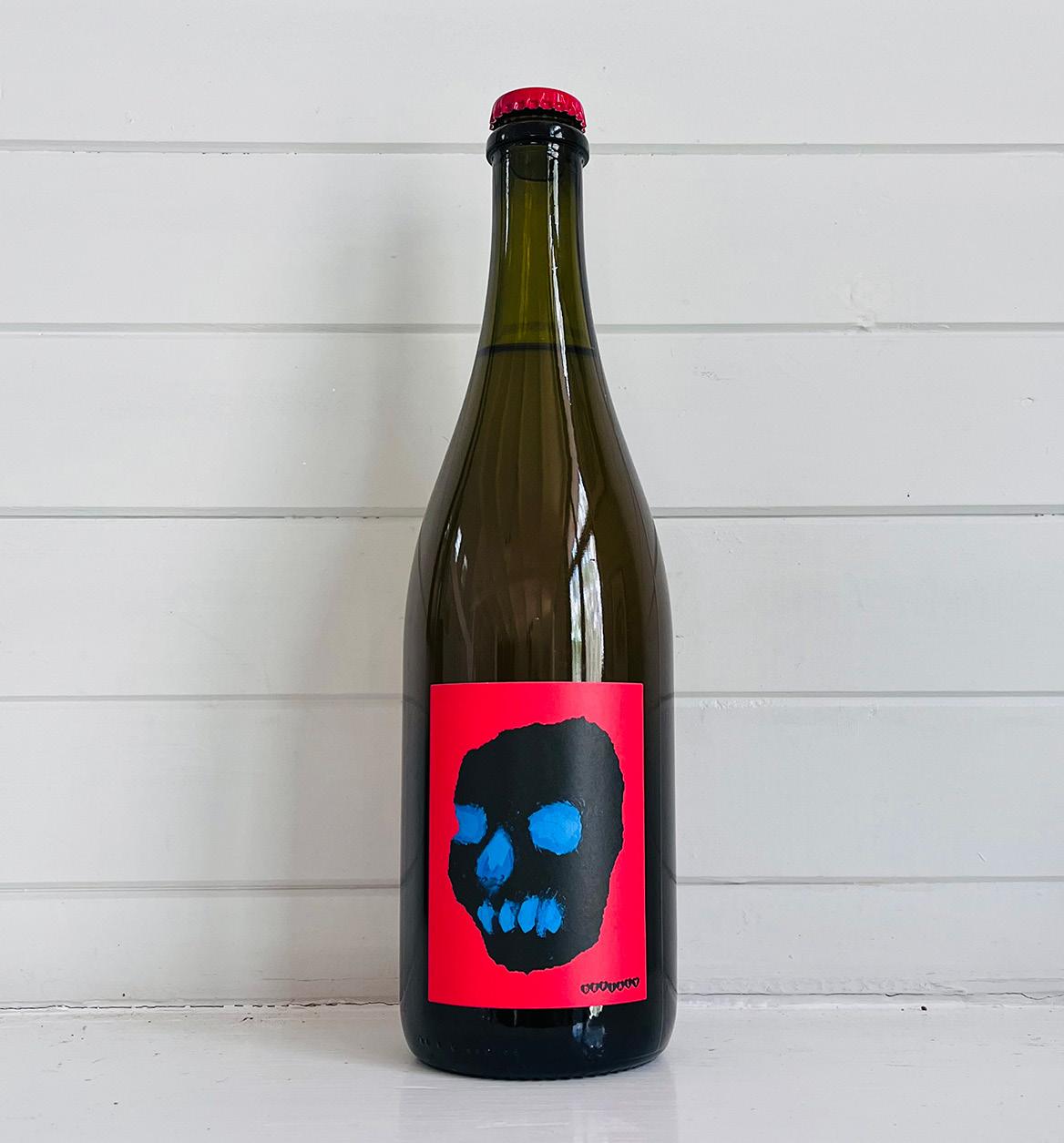

“Piquette is probably where pet-nat was five years ago where no one really knew what it was.”
– Micah Hewitt

DAVID BAE DIDN’T really have a choice when it came to his career path — it was hospitality or nothing. He essentially grew up in his dad’s venues alongside his brother, sleeping upstairs at a Japanese–Korean takeaway store in Sydney’s Kings Cross and finishing off homework at the city’s first KBBQ restaurant. “I think it was ingrained in us,” he says. “It was in my blood to take my own journey with Korean cuisine.”
The Korean culinary landscape in Australia is metamorphosising, with venues focusing on the five foundational tastes of Korean food: spicy, sour, bitter, sweet, and salty. It’s a shift from the toned-down approach that has long seen dishes muted to cater to Western palates, and signals the start of something very special.
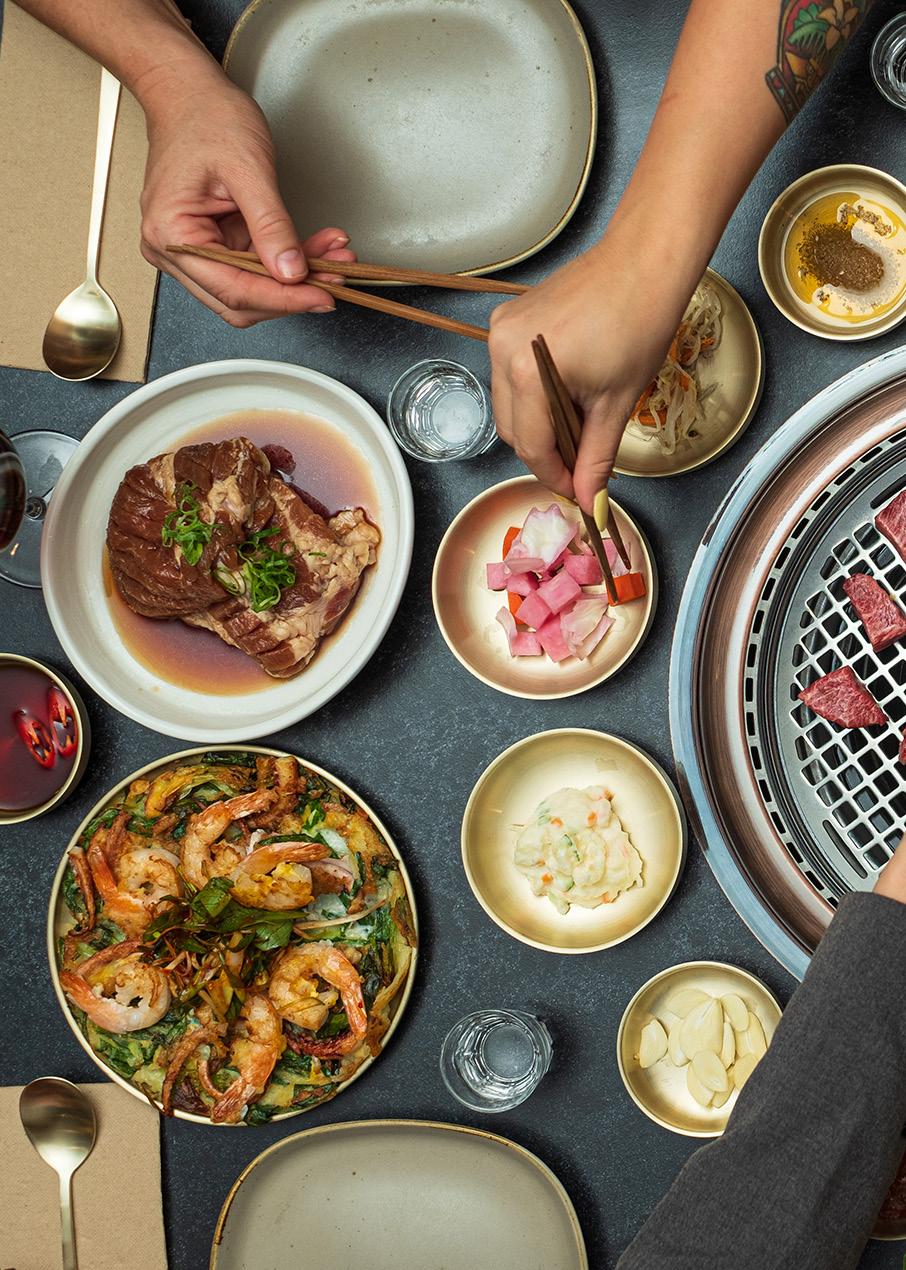

Bae is part of the return-to-roots movement and has brought his venue portfolio together under the name Kolture. He speaks to Hospitality about his upbringing, developing concepts that resonate with diners, supporting chef talent, and why everything is about timing.
David Bae’s father Donald Bae worked in entertainment in Korea before a row with a manager resulted in a snap decision to travel the globe. He ended up in Sydney and attempted to get a job at Network 10. “He couldn’t even speak English, so he had to look for something to survive,” says Bae. “He was really passionate about food, so he started learning how to be a
chef and a business owner, and that’s all he did after he landed.”
Bae’s father owned a number of eateries in Sydney, but a Japanese–Korean takeaway shop in Kings Cross and a KBBQ restaurant pack the most punch in the memory category. “The takeaway was a partnership with his brother,” says Bae. “My dad would do the night shift and I’d sleep upstairs while he would work through. Then he opened a Korean barbecue. We’d go after school and I’d do my homework there, have dinner, and then come home with him. I’ve done everything through restaurants, so I think it was always going to be about continuing to live that out.”
Like his father, Bae has been at the helm of several concepts throughout his hospo career. He was behind Moochi, one of the first frozen yoghurt chains in Australia as well as Vietnamese street food eatery Bun Me, and Korean fried chicken brand K-Bird. But his current portfolio of Korean restaurants is as relevant as ever and caters to the public’s growing interest in authentic Korean dining experiences. “Korean food hasn’t been on the map until recently,” he says. “Maybe it’s Netflix, K-pop, or diners being more open to Korean culture, but it’s still risky because you can’t just depend on the Korean demographic. Timing is obviously involved, but there was an opportunity to showcase the diversity and variety of the food.”
The nuanced nature of Korean cuisine is demonstrated by the Kolture portfolio, which




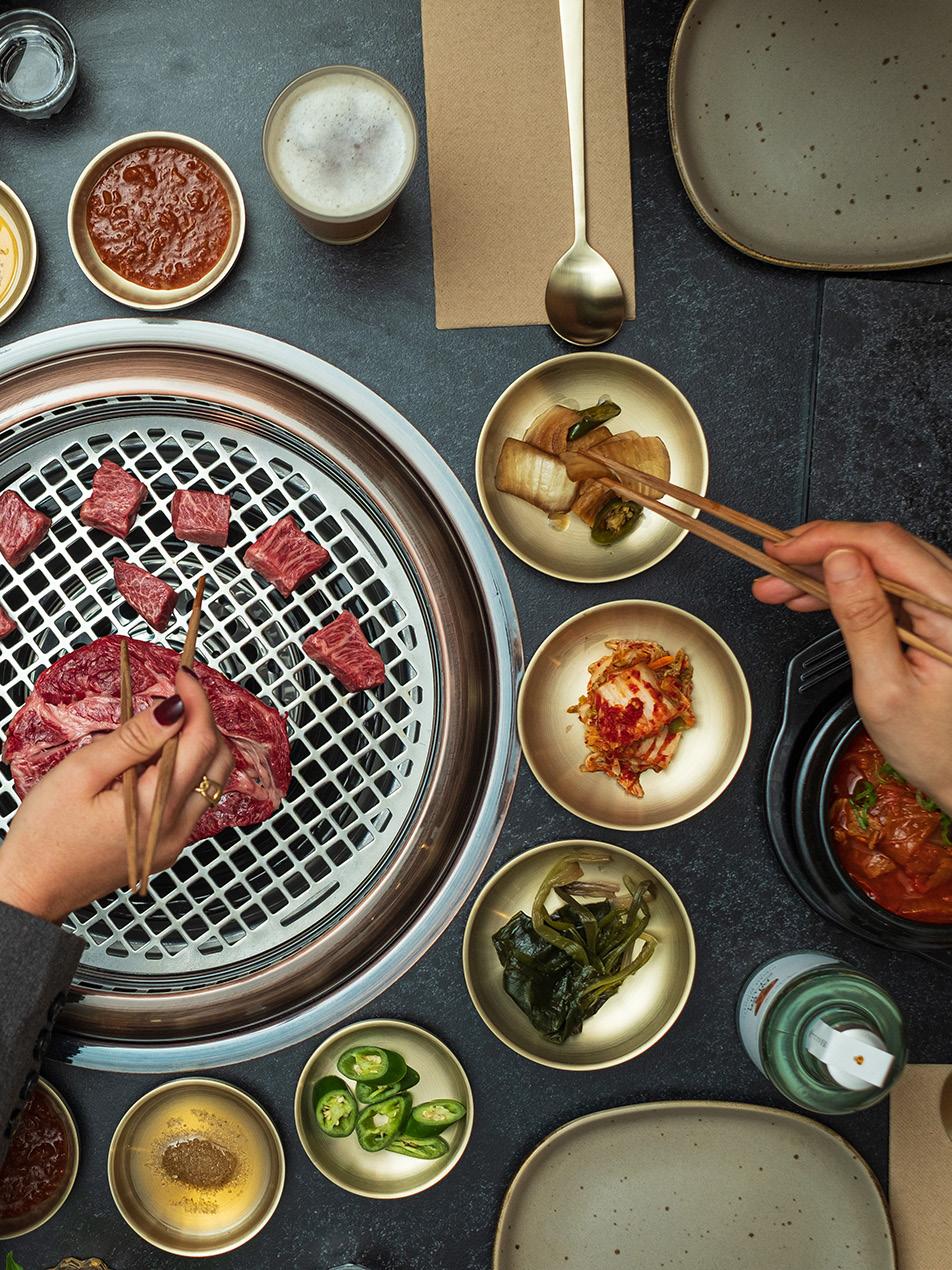
consists of Tokki, Soot, Kobo, Honey, Kogi, and soon Leemix. Each venue offers something different from omakase at Kobo to makgeolli and anju at Tokki — but they all share a common link. “Most of the venues I’ve opened are inspired by experiences I’ve had,” says Bae. “I go to Korea often, and the dining scene is on another level. Every time I go there, I think about what experiences would work in Sydney or Australia, and they’re the types of places I’ve brought back and set up over here.”
Each venue opening brings about its own set of challenges, as do established brands, and owners are faced with the reality of running restaurants: remaining agile. “When you’ve been doing things for a while, it’s not just about your passion, you have to make business decisions that make sense,” says Bae. Both Tokki and Honey have recently undergone a series of modifications, with Bae and Executive Chef Jacob Lee working together to ensure the longevity of both businesses.
Tokki launched in 2019 as a Japanese–Korean izakaya but has now morphed into an anju bar. “Tokki was successful, but it was growing a bit old,” says Bae. “It might have been confusing to the consumer because it was Japanese and Korean, but now we’re just going down the line of being Korean, so it’s a Korean pocha and our version of a sake or wine bar.”

There’s been a shift in focus on the drinks front at Tokki to coincide with Lee’s revised menu,





with the group importing Korean beverages spanning from craft beer and premium soju to cheongju, umeshu, and makgeolli. “We’ve been directly bringing in these boutique drinks booming in Korea that aren’t here yet,” says Bae. “It’s an opportunity for us to showcase them at Tokki and pair them with anju from Jacob.”
Honey in Darling Square has also changed its culinary direction, moving away from dishes such as bulgogi pizza to a more traditional offering which includes a bossam tray filled with banchan and different types of ssam. “We’re doing a more authentic take at Honey,” says Bae. “With the demographic in Darling Square, we had to take a step back and make it more authentic. Before, we were wanting to find foods that weren’t too salty or punchy, but Korean food is what it is — you can’t reinvent the wheel. It was always the fear factor of Korean food, like: ‘Is this too strong for people?’ But it’s been received so well.”
2023 marks a big year for Kolture with the launch of two new concepts and counting. Soot opened in Barangaroo last month and is a space where Australian steakhouse influences collide with KBBQ. Leemix will arrive shortly after in Sydney Place, with the eight-seater described as the elevated sibling of the Lee-led Kobo. “It sounds biased, but I’ve probably got the most talented Korean chef in the country
purely based on Jacob’s understanding of the cuisine,” says Bae. “I’ve given him the autonomy and freedom to come up with certain dishes and that has allowed his talent and colours to flow. He loves music and playing around with dishes, so I said, ‘Why don’t we call it Leemix?’ It’s a finedining version of what Kobo is.”
Soot has taken the place of Marble and has been fitted out with a state-of-the-art exhaust system that sees smoke sucked up from tables, not the ceiling. It was an essential part of the brief for Bae, who wanted to combine the social, interactive experience of KBBQ with a premium wine and beverage offering.
“When you go to Korean BBQ, you don’t really expect to have the full bar experience and you’re more accustomed to drinking soju or beer,” he says. The cuts are also a departure from the usual KBBQ selections.
“The primary difference is that we’re incorporating more Western cuts including tenderloin and rib-eye. We wanted to bring both worlds together where people can eat, drink, and chat.
A KBBQ buffet in the city is also in the works, as is a high-end KBBQ restaurant in Double Bay which is slated to launch in 2025. While Bae isn’t personally a fan of the buffet format, he says the market is very much there — as is the one for wholesale. “Wholesale is crying out to me,” he says. “I have a really talented group of chefs around me from my Kogi chef who makes his own kimchi and meat marinades
to some ladies I’ve just hired who only do banchan. One has a background in surasang [Royal Court cuisine] where they make 30–40 side dishes and serve them with a bowl of rice. I want to get Korean food on the shelves and be a part of that space one day.”
Kolture is emerging as a serious player in restaurant landscape with venues that are very much on the cutting edge for Sydney. Seoul may be 10 years ahead, but there’s plenty of time to play catch up. ■


“When you’ve been doing things for a while, it’s not just about your passion, you have to make business decisions that make sense.” – David Bae



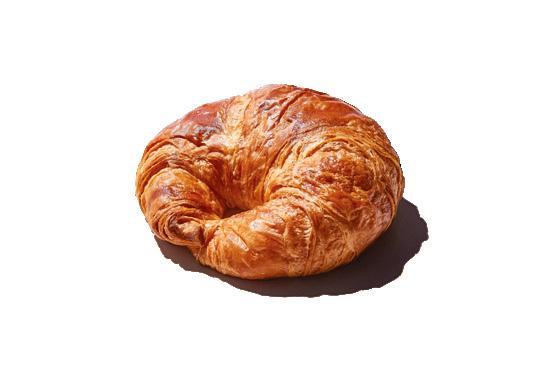

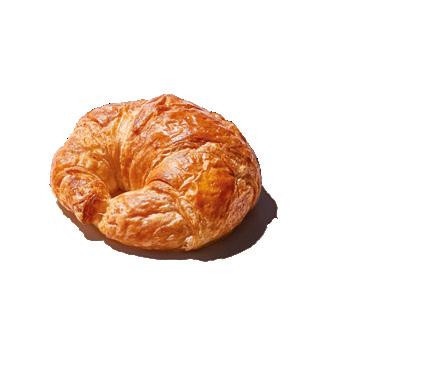
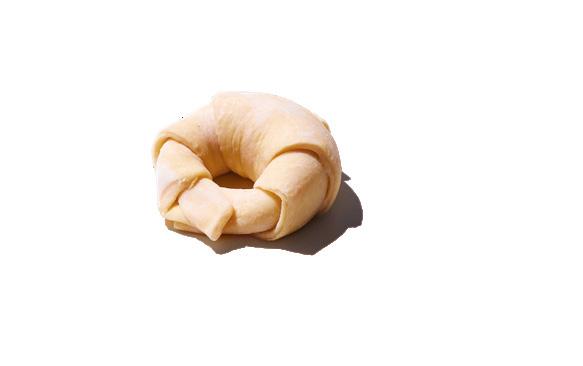


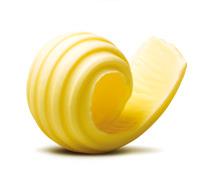
New-wave venues are channelling nostalgic, American-style pizzas.

PIZZA IS HEARTY, comfort food whether it’s the cheese, wafer-thin crust, or controversial triangles of pineapple on top — yes, we went there. While the Italians were the first to craft the flatbread with tomato and cheese, pizza has branched out considerably when it comes to style. The US has a diverse pizza offering that includes everything from the rectangular Detroit to Chicago deep-dish and the thinner-based New York.
Here in Australia, local operators have taken inspiration from their US counterparts and are bringing an element of nostalgia to the table. Hospitality speaks to Paul Kasten from Deep End Pizza and Ben Fester and Drew Huston from City Oltra about their offerings and how they’re serving the iconic food.
Self-confessed pizza nerd Paul Kasten is originally from the US and opened Deep End Pizza in Melbourne’s Fitzroy almost a year ago. Kasten spent time working at fine-dining restaurants in cities known for their pizza styles, so it’s safe to say he has covered a lot of ground. When the chef came to Australia, it didn’t take long for him to identify an opportunity to produce something a little different. “I saw a gap in the local market here in Melbourne in terms of high-quality, American pizza styles,” he says.
The premise behind Deep End Pizza is inspired by iconic pizzerias including Blue Pan in Denver; Apizza Scholls in Portland; John’s of Bleecker Street in New York, and Tony’s Pizza Napoletana in San Francisco. The venue serves three styles, the first of which is New York, which Kasten describes as an iteration that focuses on quality over quantity. “It is what you think of as the typical round, thin-crust pizza with big, foldable slices,” he says. The second is Detroit, which has a “thick, rectangular,


focaccia-like base with a rim of crispy cheese”. More work goes into creating the Detroit, which requires the base to be handled at least six times before serving. “To get these as light and crisp as possible, we go through a very labour-intensive par-baking process to get the crumb light and open.” The third is the stuffed Chicago style. “It is the deepest and most over-the-top version of deep dish built more like a pie with cheese and toppings between two layers of crust and sauce on top.”
Each option has a different dough with varying flours, mixing times, and methods. But they all use single-varietal flours from Provenance Flour & Malt and instant dry yeast to allow control over fermentation. The New York pizza bases go through a poolish method (pre-ferment added to the dough) and undergo a 24hour fermentation. “It gets us to a finished texture and flavour reminiscent of a crusty artisan bread loaf rather than a typical pizza dough,” says Kasten. The Detroit pizza dough rests for 48 hours to develop balance of structure while the Chicago pizza uses dough from the previous day that is dialled up with oil.
Deep End’s menu lists plenty of traditional pizza flavour combinations that all have slight modifications. “We have favourites available with a twist or two, which adds depth and complexity but still feel very familiar,” says Kasten. An example is the mortadella pizza, which is teamed with pickled chilli cream cheese and spring onion along with the hot salami, which features hot honey and ’nduja.
On the more experimental part of the menu, there’s the ‘tacos impastor’ with guajillo-achiote cured pork belly, roast pineapple, coriander, and salsa verde and the potato carbonara with mascarpone, mozzarella, potato, egg yolk, grana, and guanciale.
“The majority of our pizzas are based on classics, and I think a lot of people who come in get a feeling of nostalgia.”
– Drew Huston
“The reception has been better than we ever could have hoped,” says Kasten. The Chicago pizzas have been the venue’s best seller so far.
them rounds and squares in the shop to keep things simple. The rounds are like a New York slice where you can hold it in your hand and walk away.” On the flip side, the squares are comparable to a Detroit style or Sicilian pan pizza with bigger crusts and cheesy corners.
Dough-wise, City Oltra uses Provence Flour & Malt’s Spitfire flour, with the rounds sitting at 58–60 per cent hydration, and the squares at 68–70 per cent. The dough ferments for 48 hours, before it’s stretched and placed in the venue’s deck oven. The temperature is set at 300 degrees Celsius for squares and 400 degrees Celsius for rounds, with both bases cooked for 10 minutes before they’re topped and put back in the oven for an additional 10 or so minutes. “The square bases are super airy and have a crispy bottom and pillowy top,” explains Huston. “The rounds are cooked at a lower temperature for slightly longer for a bit more structure.”
The toppings and flavour combinations on the 16-inch rounds and 10x14-inch squares are available to order half and half and are driven by seasonal produce. “We deal with a few smallscale farmers and suppliers and tend to order small amounts of produce and test some things out,” says Fester. “We don’t stick to anything too traditional — we do like to have fun with it.”
Both venues offer pizza by the slice for eat-in and takeaway
“The novelty of serving the only accurate deepdish in town and the desire to get a cheese-pull picture has really driven the Chicago style to be our top seller from the beginning.”
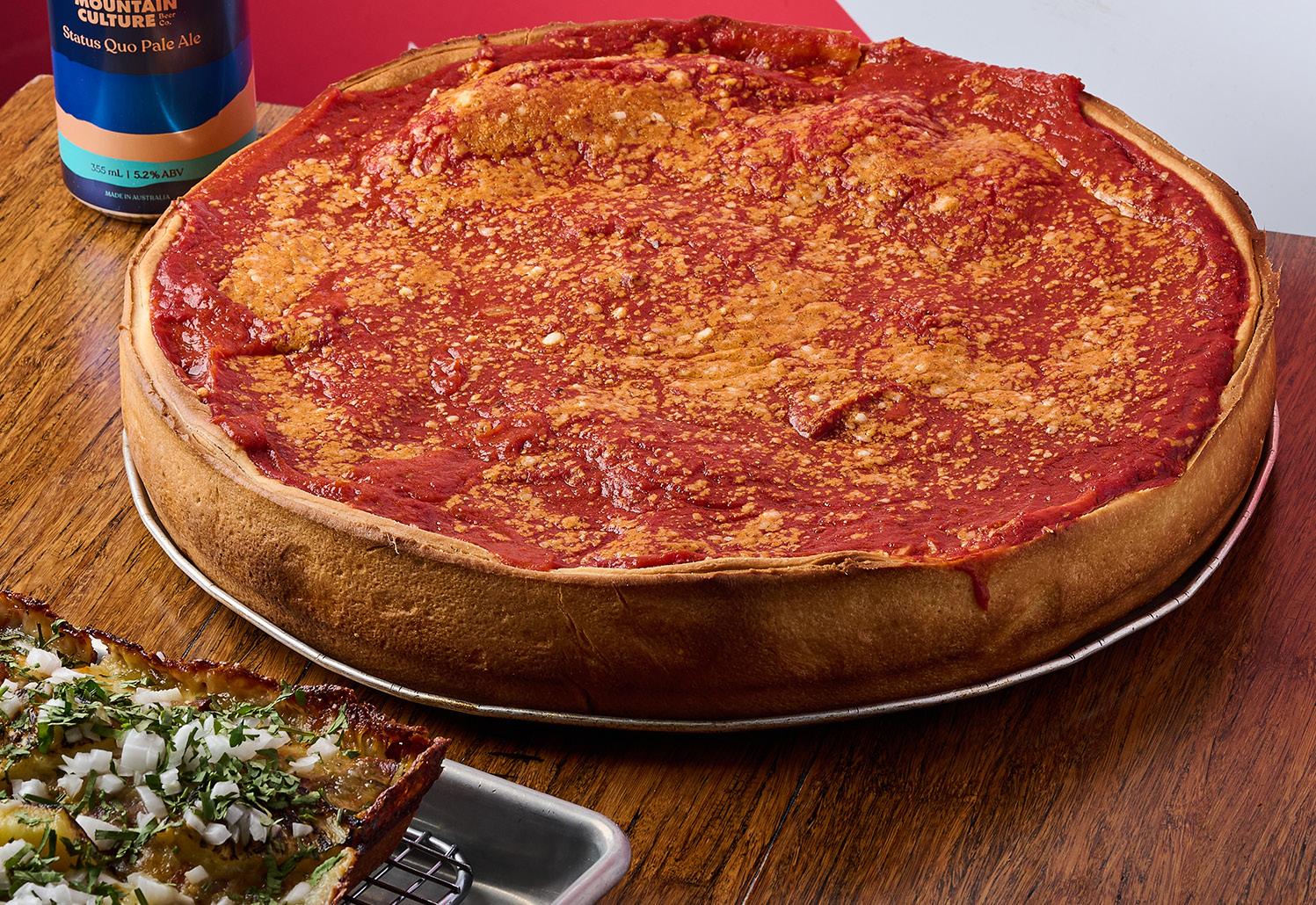

Ben Fester and Drew Huston are behind City Oltra located in the Eddy dining precinct at Sydney’s Central Station. You may have come across the duo’s pizzas before at Poor Tom’s Gin Hall in Marrickville under the name Oltra Disc.
Some of the highlights from the menu include artichoke purée and hearts with gorgonzola and honey along with the ‘rancho relaxo’, which combines hot pepperoni with cool ranch, red sauce, and cheese. The venue also serves up pizzas by the slice, which helps cater to a range of diners. “It’s nice to have some people sit at the bar with a few slices and others come in for a couple of hours.”
City Oltra serves ranch sauce with its pepperoni pizza
City Oltra is part of Central Station’s Eddy precinct in Sydney Deep End Pizza’s Chicago deep-dish is the mostordered item
“We started off making pizzas together and doing pop-ups while working full-time jobs,” says Fester. “We thought, ‘This is a pain, we should actually just get a place’.”
City Oltra serves up pizza styles akin to those found across America, but rather than calling them by recognisable names, the pizzas are referred to as ‘rounds’ and ‘squares’. “We’ve got to these on our own from experimenting without trying to copy any style,” says Fester. “We call
For City Oltra, a menu with familiar classics and some different flavour profiles is important. “The majority of our pizzas are based on classics, and I think a lot of people who come in get a feeling of nostalgia with the pizzas they had growing up,” says Huston. But that’s not to say you won’t see something new. “We’ll continue to try and push ourselves and be a bit more inventive with toppings depending on what produce we get in,” says Huston.
It’s clear the roots of City Oltra and Deep End Pizza hail from regional American pizzas, but both teams have incorporated an innovative aspect to keep diners engaged. It’s just one example of chefs chanelling the old with the new and familiarity with experimentalism, which is seeing no shortage of high-quality, inventive dishes hit the table. ■
Hostplus is a top-performing super fund that puts members first. That’s why we’re proud to have been named the 2023 Fund of the Year by third-party ratings agency SuperRatings. Judged across three areas: strong performance, competitive fees, and an ongoing focus on members, we’re thrilled to receive this recognition.
The rating is issued by SuperRatings Pty Ltd ABN 95 100 192 283 AFSL 311880 (SuperRatings). Ratings are general advice only and have been prepared without taking account of your objectives, financial situation or needs. Consider your personal circumstances, read the product disclosure statement and seek independent financial advice before investing. The rating and awards are not recommendation to purchase, sell or hold any product and are only one factor to be taken into account when choosing a super fund. Past performance information is not indicative of future performance. Ratings are subject to change without notice and SuperRatings assumes no obligation to update. SuperRatings uses objective criteria and receives a fee for publishing awards. Visit www.lonsec.com.au/superfund/ratings-and-awards/ for ratings information and to access the full report. © 2022 SuperRatings. All rights reserved. General advice only. Consider the relevant Hostplus PDS and TMD at hostplus.com.au and your objectives, financial situation and needs, which have not been accounted for. Awards and ratings are only one factor to consider. Host-Plus Pty Limited ABN 79 008 634 704, AFSL 244392 trustee for Hostplus Superannuation Fund, ABN 68 657 495 890. HP2387
The cockerel is renowned for its integrity, marigold flesh, and unrivalled flavour profile.
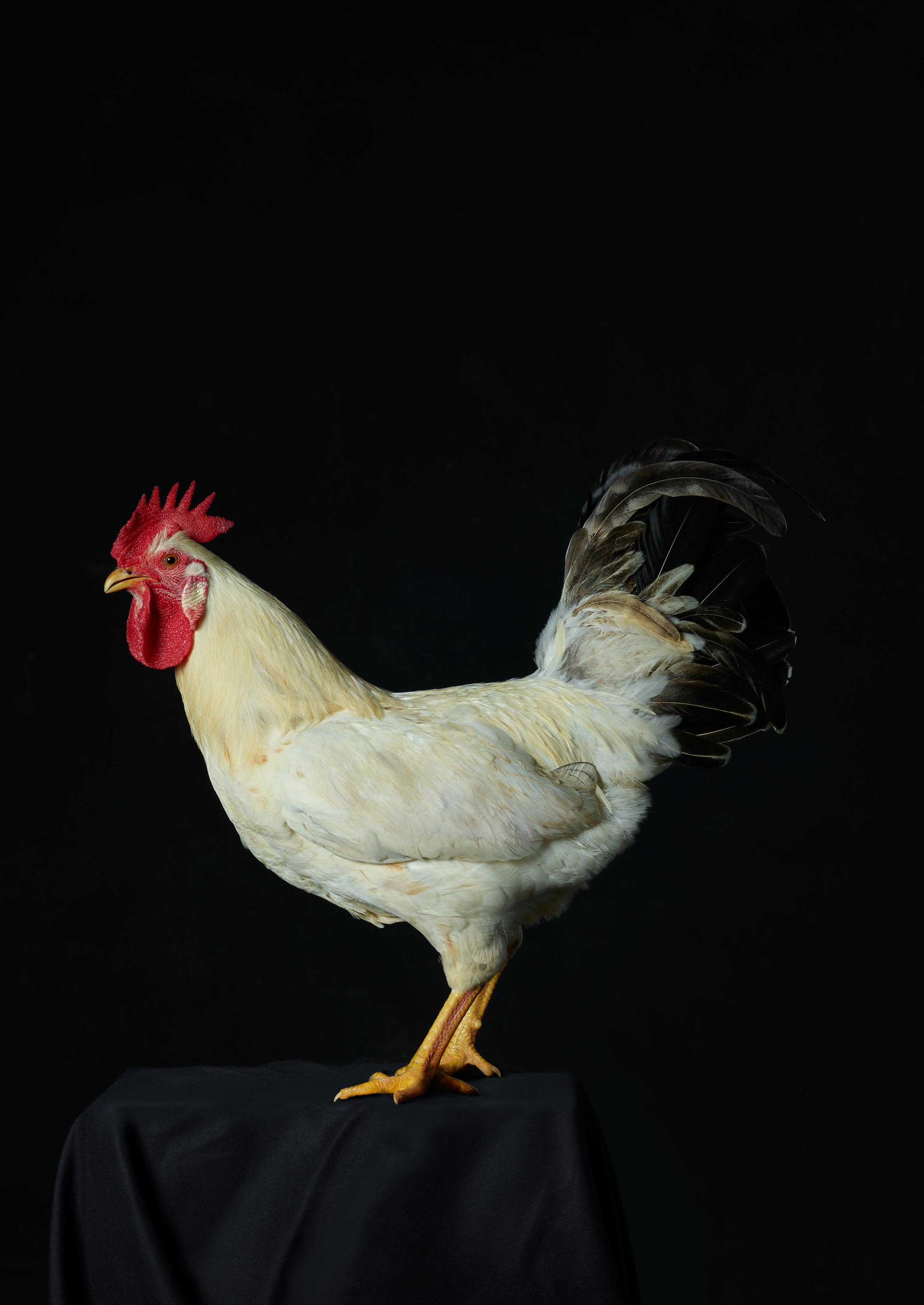
WORDS Annabelle Cloros
PHOTOGRAPHY Kristoffer Paulsen
CHICKEN, DUCK, QUAIL, and turkey are likely the first birds that come to mind when you think of poultry in the Western world. But cockerel has long been an integral protein across Asian cuisines and is the focal point of foundational dishes that see the golden bird poached, steamed, and curried.
It’s difficult to draw comparisons between chicken and cockerel. For one, the flesh is marigold in colour and firm; almost al dente. As for the flavour, many chefs have compared it to the chicken they grew up eating in Japan, the countryside of France, and Italy.
In the poultry world, a considerable amount of time is required to farm cockerels compared to standard broiler chickens, which is part of the reason why the bird is not as accessible or widely consumed as its mainstream counterpart. The other cause is linked to education and awareness — but it’s starting to change.
Hospitality speaks to Pho Nom Chef Jerry Mai about her experiences with cockerel growing up and Aurum Poultry Co.’s Henning Skallebaek and Kenneth Chan about the history of the cockerel, the realities of farming, and its growing presence at restaurants.

Aurum is a Victorian-based poultry company that works with boutique farms to supply
chicken, cockerel, duck, and game birds reared according to low-density practices. Farms are located across the state from Gippsland and the Mornington Peninsula to Colac, Golden Plains, Rockbank, and Werribee.
The cockerel is part of Aurum’s range and is a specialty bird that’s not easily farmed. Cockerels necessitate patience and consistency — two words that aren’t synonymous with the meat industry. “There’s not many cases of growing cockerel successfully around the world because it takes a lot of time,” says Kenneth Chan. “Farming cockerel is less economical, and it takes years to find a farming approach to grow the chicken.”
“But it’s easier than a meat chicken because there are less birds in the shed,” adds Henning Skallebaek. “They grow for a longer time but they’re a lot easier to work with — until they get more active when they get closer to sexual maturity. Once they mature, you get a tough bird, so it’s about getting the balance right. We’ve been doing this for 13 years now and we’re still learning and improving the product.”
To compare, a broiler chicken weighs 3kg by the time it is six weeks old. Cockerels weigh around 2kg by the time they’ve reached maturity, which takes between 15 and 16 weeks. The process
“It has that gai flavour, which is from slow farming.”
– Kenneth Chan
begins with day-old pullet hatchlings that are technically categorised as a byproduct. The chicks are placed in a shed heated to 32 degrees Celsius for one week before the temperature is steadily reduced until the birds no longer require temperature intervention. “The farmer will check on the birds up to three times a day to observe the conditions in the shed and monitor behaviour,” says Skallebaek. “The chicks are weighed every week, which is a way of keeping track of how the birds are performing.”
Shed conditions play a pivotal role in the final product, with most cockerels raised in traditional barns. Water and feed are placed near the birds to ensure they don’t need to walk far to eat and drink, and the temperature and amount of light in the barn is also regulated by farmers. “Airflow is very important to keep the litter dry,” says Skallebaek. “If it gets wet, the air in the shed will be impacted and that will impact the optimum growth of the bird. You don’t want too much light in there as the cockerel is a more aggressive bird and it will move around too much. Farmers can control the temperature in some of the sheds down to 1 degree.”
The feed consumed by cockerels is different to what broiler chickens eat. Aurum’s cockerels are given feed that’s been tailored according to its lifespan. “Our birds eat three times more compared to a normal chicken,” says Skallebaek. “The cockerel isn’t a meat bird, and it hasn’t been genetically developed to use all the protein and energy in normal feed, so ours has a bit less. We also add natural products such as marigold which helps the bird develop that beautiful yellow colour.”
The growth phase of a cockerel is almost three times longer than a broiler chickens, and the end result is a very different protein. The bird is distinguished by its yellow skin and firm flesh, which is achieved through feed and its growth cycle. “The meat texture is bouncier, and the main reason is because the chicken has more space to move around,” says Chan. “It’s not as technologically advanced and it has that gai flavour, which is from slow farming. When we taste chicken in Asia, we always say, ‘What is the gai flavour?’ to categorise it like you would with red wine and tannins. Every time we present cockerel to chefs, they say it reminds them of their home country. A chef from Yakikami said it’s like the chicken they use in Japan and another from Il Bacaro said it reminded him of the chicken he grew up eating in Tuscany.”
Cockerel is an integral ingredient in Asian cookery, with Aurum referring to it as Fook Wong chicken which translates to happiness. “In Chinese culture, chicken is always a centrepiece dish for gatherings with family and friends, especially during Lunar New Year,” says Chan.
It’s the key ingredient in Hainanese chicken rice and steamed ginger chicken, as well as the classic French dish coq au vin. Pho Nom Chef Jerri Mai grew up eating cockerel, with her parents sourcing birds from farms and preparing them

at home. “I grew up in Springvale and cockerel was quite available, but outside of Vietnamese and Asian communities, they were quite hard to find,” she says. “Cockerel was something you didn’t really eat, but it’s always been on our table and available in the Asian community.”
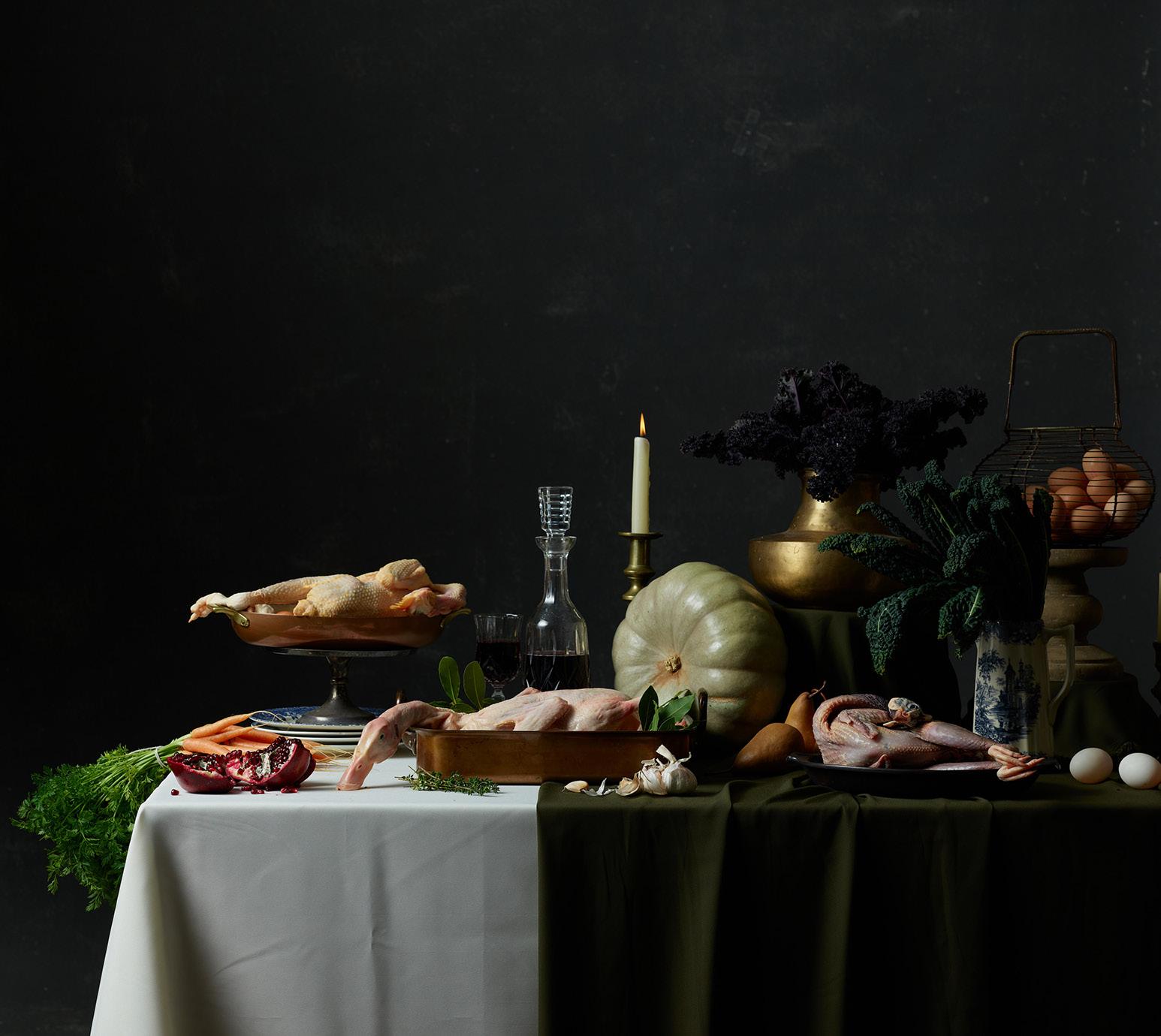
Mai says it all comes down to education and experience — the reality is most Australian consumers know and only eat broiler chickens. Cockerel is not a common find on menus outside of Asian and classic French settings, which means the more chefs use it, the more the public will understand the protein and its characteristics. “It’s a great product — the flesh is firmer, and the bones create depth of flavour and more sweetness whether you’re using it in a soup, steaming it, or stir frying it,” says Mai.

The chef preferences steaming as the top cooking method when it comes to cockerel, with the meat teamed with dipping sauces, soy, or salt and pepper. “The way my mum prepares it is steaming or poaching with spring onion and garlic, so you get to taste the full flavour of cockerel,” says Mai. “You steam it for 35–40 minutes and the skin becomes taut. I also have it with Vietnamese curry which is rich with coconut cream and has just a little bit of curry powder, so it’s quite gentle.”
The main thing to remember is that there’s
not many limits when it comes to culinary applications, which span from using the bird in soups and broths to being braised in a wine-rich sauce or roasted. “It’s an all-rounder product,” says Mai. “When I cook stock, it’s quite sweet from the bones. The golden fat under the skin renders out really well and adds depth of flavour. People just need to understand how to handle it. It would be good for people to buy it and give it a go.”
While Mai hasn’t featured cockerel on the menu just yet, there are some pop-ups in the works that will include dishes with cockerel. “I haven’t run cockerel before just because of not being able to get it and not knowing the suppliers, but I’ve always wanted to educate people on cockerel, so I will be focusing on it at my next events.”
Aurum has noticed an uptick in demand for the bird, but it’s a matter of availability given its slower growth cycle. “We have never been out there pushing it because we struggle to have enough,” says Skallebaek. “There’s also a price point because they cost more to produce, but we’re seeing more interest from modern Asian restaurants and top-end Western restaurants that are starting to pick it up. We want people to experience real chicken.” ■
Cockerel is used in Hainanese chicken rice

Marigold in the feed turns the cockerel’s skin yellow

Cockerels are reared from day-old pullet hatchlings
The birds are raised in traditional sheds
“Cockerel was something you didn’t really eat, but in the Asian community, it’s always been on our table and available.”
– Jerry Mai
Ideal for making sauces and gravy
An essential for making silky, lump-free sauces.
Long handle facilitates easy manoeuvring
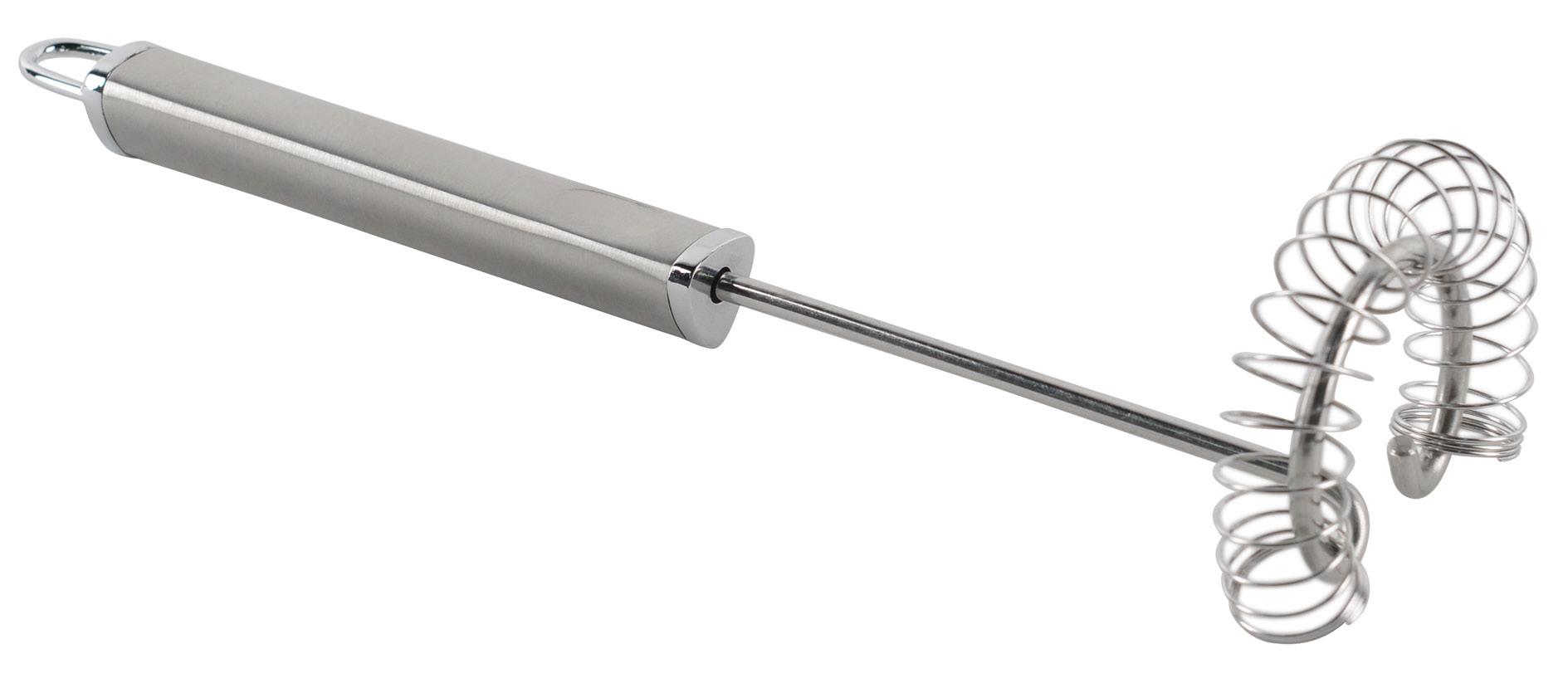
Whisk on an angle
Stainless steel prevents ingredients from sticking
Spiral head with flexible coils allows access to hard-to-reach corners and edges
Designed to break up lumps while stirring
Use flat to deglaze


I MOVED TO New York when I was 20 years old. It was an intimidating setting but the smartest thing I’ve ever done. The minute I turned 21, I put my hand up to work in a Spanish tapas cocktail bar in Hell’s Kitchen. By day, I was serving patatas bravas and sangria and by night the venue turned into a secret underground nightclub until 6am. It totally changed my idea of what hospitality was — it was pure entertainment and the place was alive. I wanted in then and there.
Frankie’s Pizza in Sydney was where I really started to excel. I got to experience the good, the bad, and the ugly and I really learned a lot about myself and my industry. It was pure magic running that place. I saw the beast roll through lockout laws and restrictions and evolve with changes the industry is constantly faced with.
After a five-plus-year stint at Frankie’s, I took maybe a week off and got bored. I caught wind of Odd Culture locking down The Duke and my ears pricked up. Jenna Phillips, James Thorpe, and I had coffee while they shared their plans for The Duke. It was then decided I would be the harbinger of the new era for The Duke. I’m so proud of what The Duke has become and the community we built.
I moved into a group operations and entertainment position at Odd Culture around 12 months ago. I’m really zeroing in on entertainment at Pleasure Club and putting myself in the shoes of guests. I cannot wait for everyone to get down to Pleasure Club — it’s what Sydney needs more of right now. I’m planning a sevenday-a-week, late-night roster of free live bands across a breadth of genres spanning
uber-cool dirty jazz, meat and potatoes rock ‘n’ roll, and a bit of an update of the blues age-old theme of ‘sell-yer-soul to temptation’. It will see an iconic and unmatched live entertainment offering in Newtown with surprise midnight sets.
I think Pleasure Club’s 4am licence will change the perception of what that licence means. Most people think of house music, nightclubs, and trouble — it will be the opposite of what you are expecting. I think you’ll find venues like Pleasure Club will change the scene a lot and have such a positive spin on our industry and Sydney’s nightlife. We have such incredible late-night venues already, and it’s an honour to be able to continue bringing more heat back to the scene. Get in early and buckle up for good times ahead at Pleasure Club. ■

Nearly 60 years in market, Hospitality magazine is a stalwart of the comprehensive stable of titles produced by Food and Beverage Media.

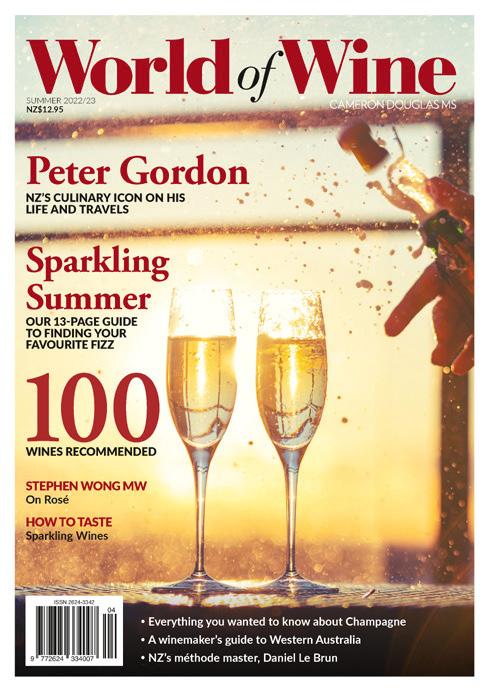
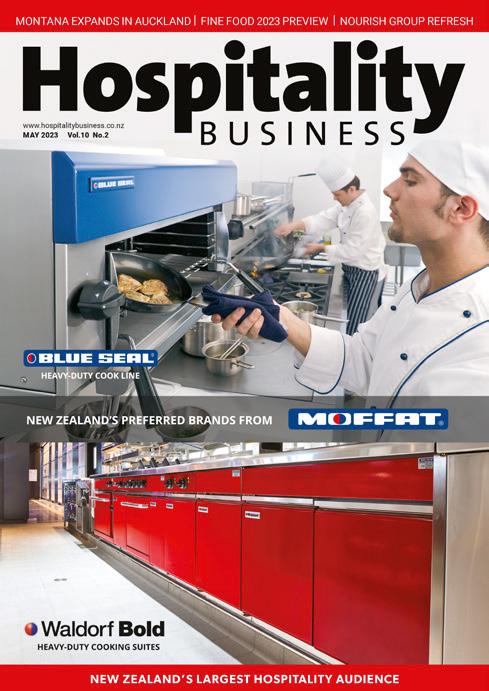

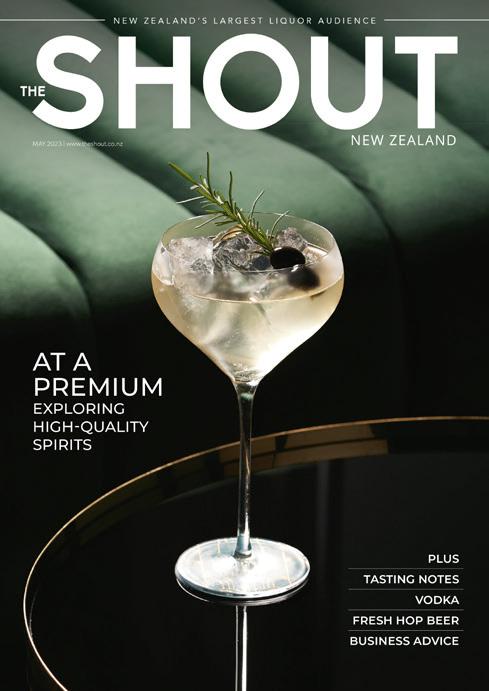

See the full range of our liquor and hospitality titles below.


Food & Beverage Media is a division of The Intermedia Group. For the best coverage of the food and drink sectors in Australia, subscribe to our titles at www.intermedia.com.au
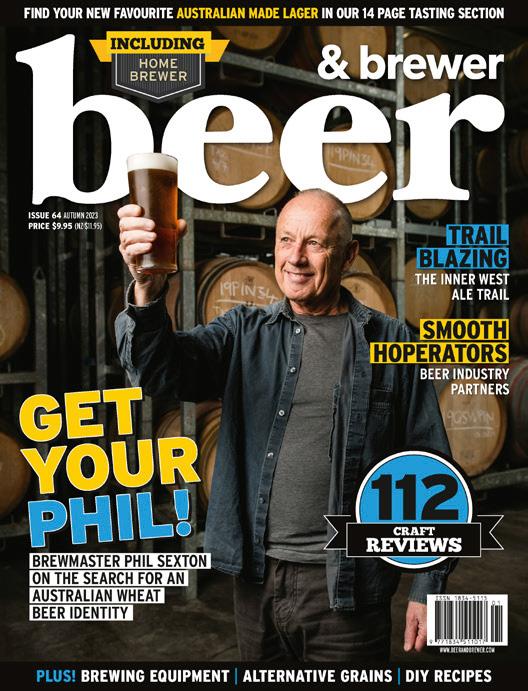
Woodson is Stoddart’s countertop kitchen and cafe equipment range that has led the market space since 1954. Designed and manufactured in Australia for Australian conditions, Woodson is renowned for its quality, functionality, and reliability.

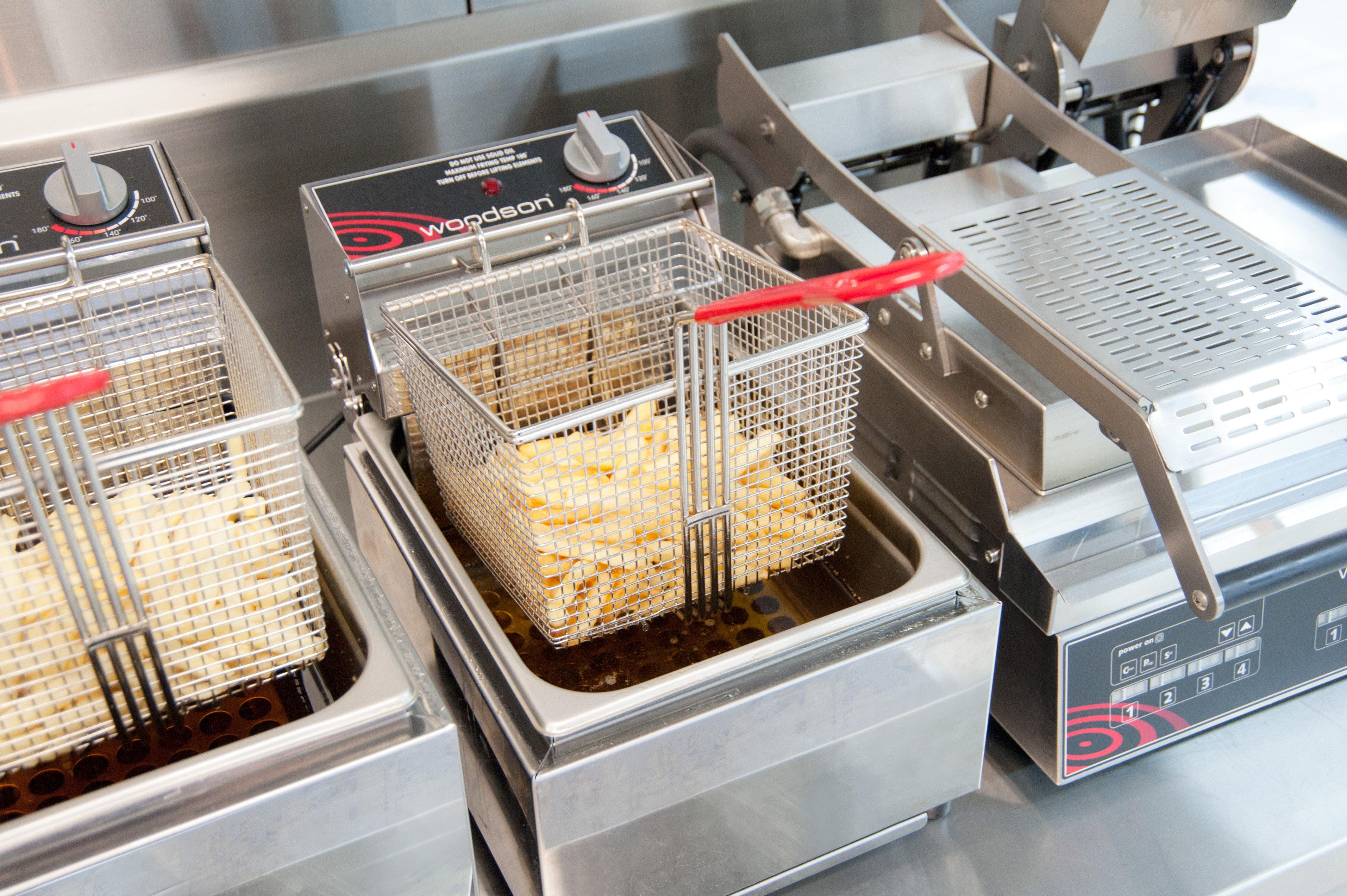
Scan to see the full range
